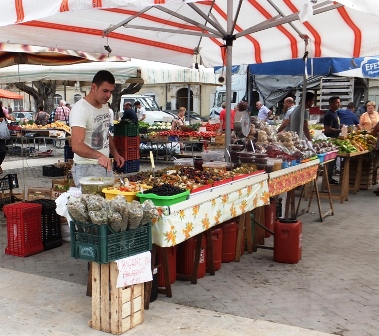
Click the photo above to see an album for Markets and Ruins. To return to our webpage, close the window.
|
|
|
Siracusa Sicily The only evidence the next morning that a big event had taken place the previous evening was a lot of garbage. I had finally fallen asleep; oblivious to any sounds of the dismantling of the large stage that had occupied the piazza last night. In its place was a large weekly market. About 2/3 of the market was for second hand clothing and garage sale type articles and the rest was taken up with fruit and vegetable stands. It was a popular place and had good fruit we bought for our dinner snack that evening. The Archaeological Park of the Neopolis was a 20 minute walk from our B&B in the opposite direction from Ortigia. Most of the city’s ancient social and religious venues were situated in the park area and therefore were never inhabited. We spent almost 2 hours touring the site. A huge Greek theatre, carved out of the natural rock face of a hill stands in almost the same condition it was when first established in the 5th C BC. As we left the Greek Theatre a young couple we met waiting for the bus to Erice recognized us. I had helped her get on the crowded bus but she ended up getting off when her boyfriend was refused a seat because the bus was over capacity. We asked how they found Erice. They told us weather had remained wet and cold that entire day but cleared for the next morning before socking in again. At least they had a little time to enjoy the town in the sunshine.
What once were the limestone quarries from which most of the stone for the city’s monuments were excavated is now called the Latomia del Paridiso (Quarry of Paradise). The roof of the quarry collapsed after the earthquake of 1693 and the quarry was planted with citrus, oleander, bay and olive trees. What really enticed us to the Latomia was the cave, Orecchio di Dionisio (Ear of Dionysius), so named, according to legend, by the painter Corravagio when he visited in 1608, because the cave opening with its 60M long curving interior resembles the inside of an ear. It most famous quality is its acoustics. My guide book said that sometimes a guide or a visitor may break into song. Just as we were leaving the cave I heard a woman’s voice start to sing. I rushed back inside to hear a young guide give a near perfect rendition of Ave Maria. What a treat for all of us. The Roman Amphitheatre was not as large or in as good condition as the Greek Theatre, but we could still image its original glory, albeit probably more gory watching gladiators and prisoners take on wild animals.
We arrived to find the waitress in the process of closing up early. That foretold what was happening to the rest of the city. We had planned to have a light supper of cheese with the fruit we bought that morning, and maybe a bottle of wine. We searched the streets again to find the only places open in our part of town were bars that didn’t serve food and one pizza place. We bought a bottle of beer at the open pizza place and returned to have our meagre supper in our room. Of course, having eaten such good meals in the past week or so we were due for a fast.
|
||||
Read Rome Sept-Oct 2013
Return to Sicily Intro
Return to Italy Intro
Return to Travels
Return to Introduction